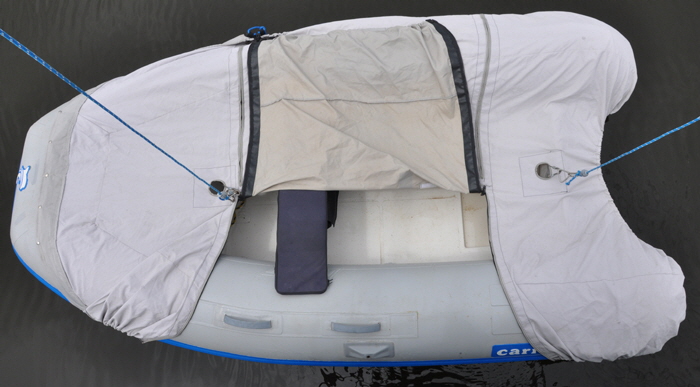The rigmarole of stretching a cover over a dinghy while it is bobbing about in choppy water prior to hoisting it on davits can become a very wet business if you're not careful. Leaning right over either end trying to stretch a cover over the wet bow and stern pods can quite easily result in a head first dip in the drink. Britannia’s dinghy is an old ten feet long Caribe RIB, so at least it has a solid floor to scramble about in. Soft bottoms are not as stable, so the chance of slipping overboard is greater.
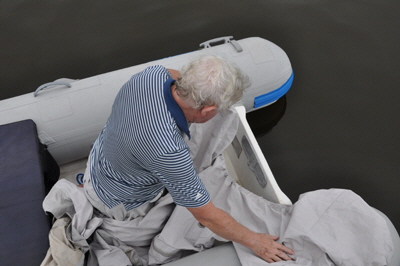 After disembarking any passengers at Britannia’s side boarding ladder, I would then hand walk myself in the dinghy to the stern where someone on deck would tie the dinghy's painter to the rail. The outboard motor could then be lifted off the dinghy transom using the crane hoist, and locked on its mount on the pushpit rail.
After disembarking any passengers at Britannia’s side boarding ladder, I would then hand walk myself in the dinghy to the stern where someone on deck would tie the dinghy's painter to the rail. The outboard motor could then be lifted off the dinghy transom using the crane hoist, and locked on its mount on the pushpit rail.
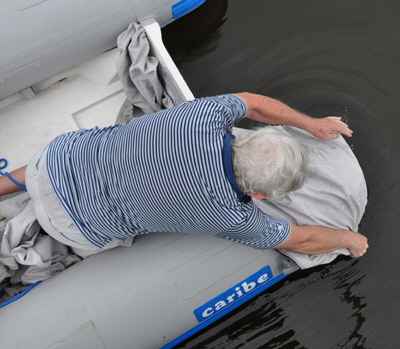 The dingy cover would then be dropped down to me, usually in a big pile, whereupon the shenanigans would begin, gleefully anticipated by anybody standing on the stern with a camera.
The dingy cover would then be dropped down to me, usually in a big pile, whereupon the shenanigans would begin, gleefully anticipated by anybody standing on the stern with a camera.
With the cover hooked over both ends, and with the dinghy now secure I could only straighten the cover on the outward side because I had to squeeze out the other side to climb up the transom boarding ladder. Every time I performed this balancing act and especially after falling in, I swore I would find a better way…
At least it was then an effortless job to hoist the dinghy to the top of the davits using my electric winch, that pulled the dink’ up in seconds, including the outboard if I had left it attached.
I considered cutting the cover in half to make two separate bow and stern sections, then zipping them together when both ends were in position. I'm sure this might work for others, but trying to attach two halves of a zip is difficult enough on land for my old hands, never mind in a lurching dinghy with wet fingers. I would have needed to stretch both halves together while balancing in the center, trying to zip the sections together, and I only have two hands. Still, I felt I was possibly on the right track, so I progressed to a better solution.
I had our local canvas man sew twin zips 4’ feet 6” inches apart from the side of the cover to the middle, that gave me a sizable “flap” to work in. It is now even beneficial to leave the seat in position, that I previously had to remove to give me more crawl room under the cover. With the flap open the cover also stretches easier on to both ends, and I can then sit on the seat to effortlessly connect the davit hoists and easily climb up the transom ladder by leaving the flap unzipped.
I tied two lengths of 1/4” inch line to the outside edge of the cover and had two small loops sewed on the ends of the zips. When the dinghy is secured on the davits I then hook the dangling cords at the back with a boat hook, and thread the ends thought the loops in the zip. When they are pulled tight these cords keep the middle of the cover from blowing about in a wind.
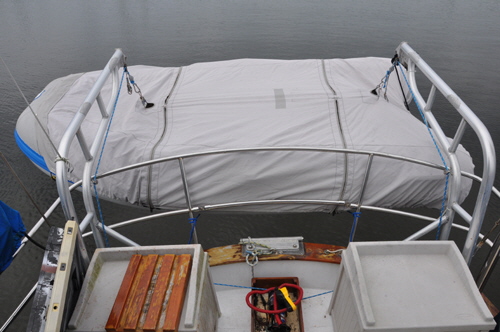 Having hoisted the dinghy to the top of the davits, it is then a simple matter to zip up the flap.
Having hoisted the dinghy to the top of the davits, it is then a simple matter to zip up the flap.
Another advantage of having the flap became apparent the first time we needed to stow our fenders in the dinghy, that we couldn't easily do before when the cover was in one piece. It is now an easy matter to just unzip the flap, stuff all the fenders and mooring lines in the boat then zip it up again.
This was a marvelous improvement that was well worth the $75.00 to just have two zips fitted to the cover.
But then I incorporated yet another modification, that was available on my dinghy, but I have not seen on other makes.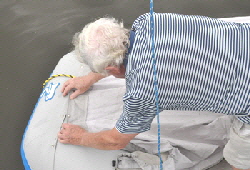
Even when the cover was wrapped as far under the bow as possible and hoisted on the davits, it would frequently be blown off by strong winds and slip off the bow where it would flap around incessantly, until stretched back into place. On Britannia this was another perilous operation because I had to lean right over the davit to be able to wangle the cover back under the dinghies bow, with a very real possibility of falling completely off Britannia’s stern.
The dinghy has a strip of canvas across the bow with five metal grommets that are used to attach a spray hood. I pop riveted press studs into these grommets and also the cover, then I trimmed the front of the cover off completely. Now, instead of having to lean right over the bow when fitting the front of the cover, I simply snap the five studs together for a safer and much more secure attachment, that has not been blown undone so far.
Finally, looking at the pictures you may think, “Why has he got a flap on both sides of the cover?” This is a keen observation, especially since I always lift the dinghy the same way round, to be able to lift the outboard with its crane. Therefore a flap on the outer side of the cover is indeed superfluous. So why two flaps? The answer is; because the canvas man stitched the first set of zips on the wrong side of the cover, so he took it back and did it again, and I got two flaps for the price of one. I have never used the other flap, but I suppose when the plastic zips eventually crack in the hot Florida sun, as they surely will, I can reposition the outboard motor and crane on the other side of the stern, then just turn the dinghy round and use the other flap. After all, on boats it's always good to have a back up isn't it?
